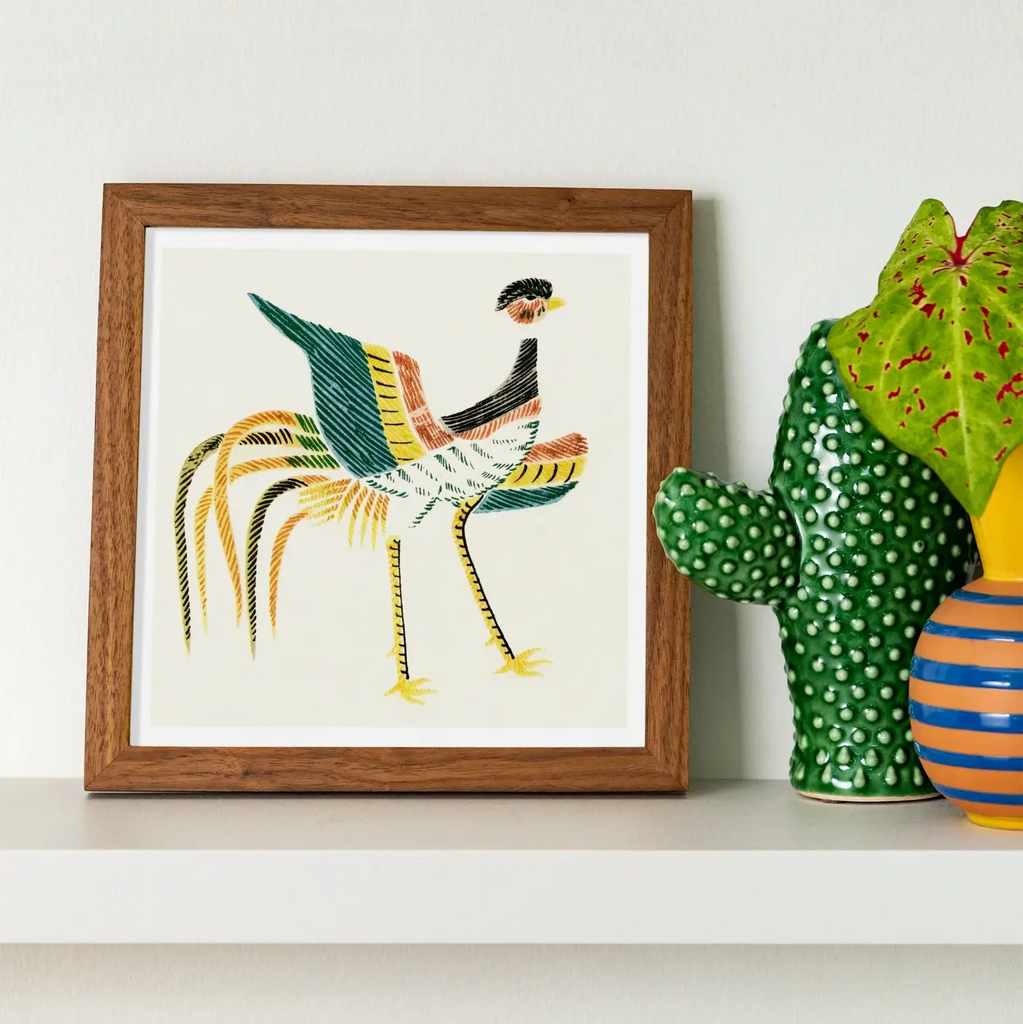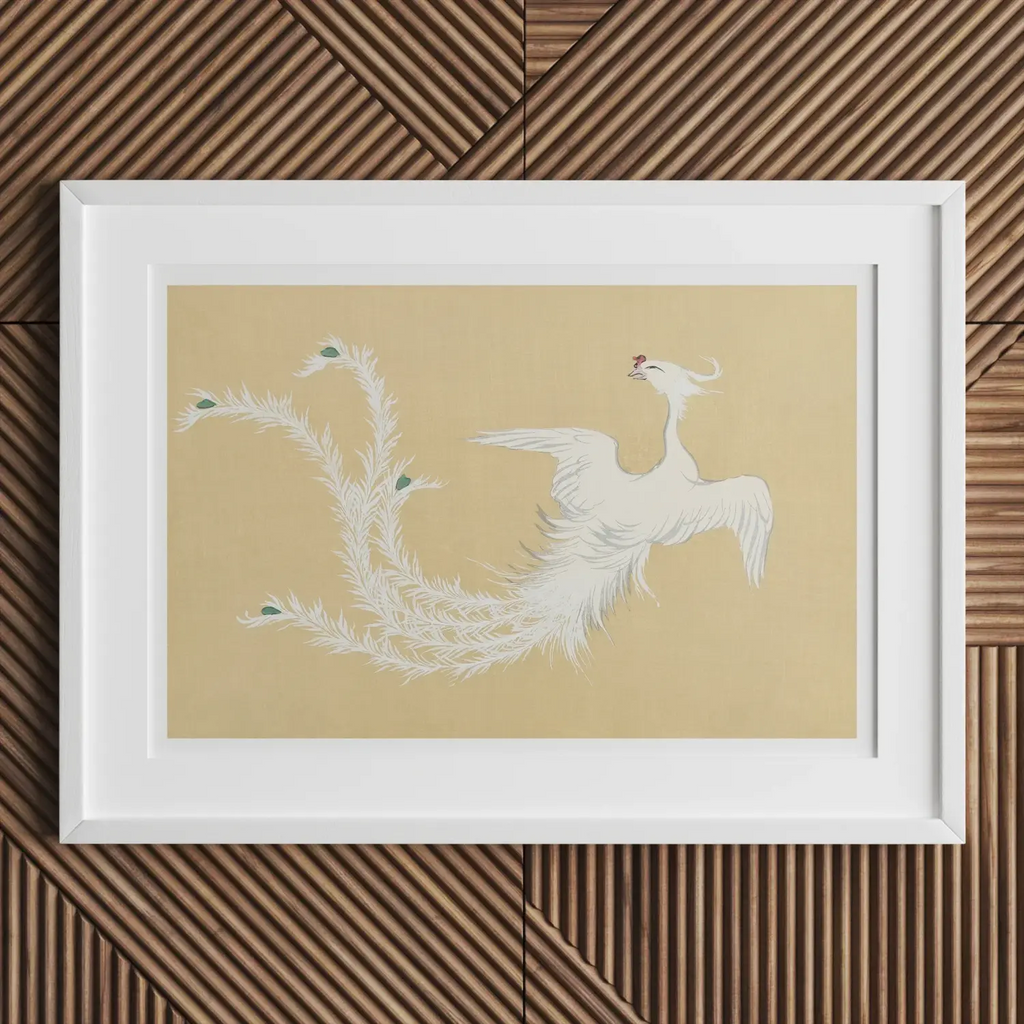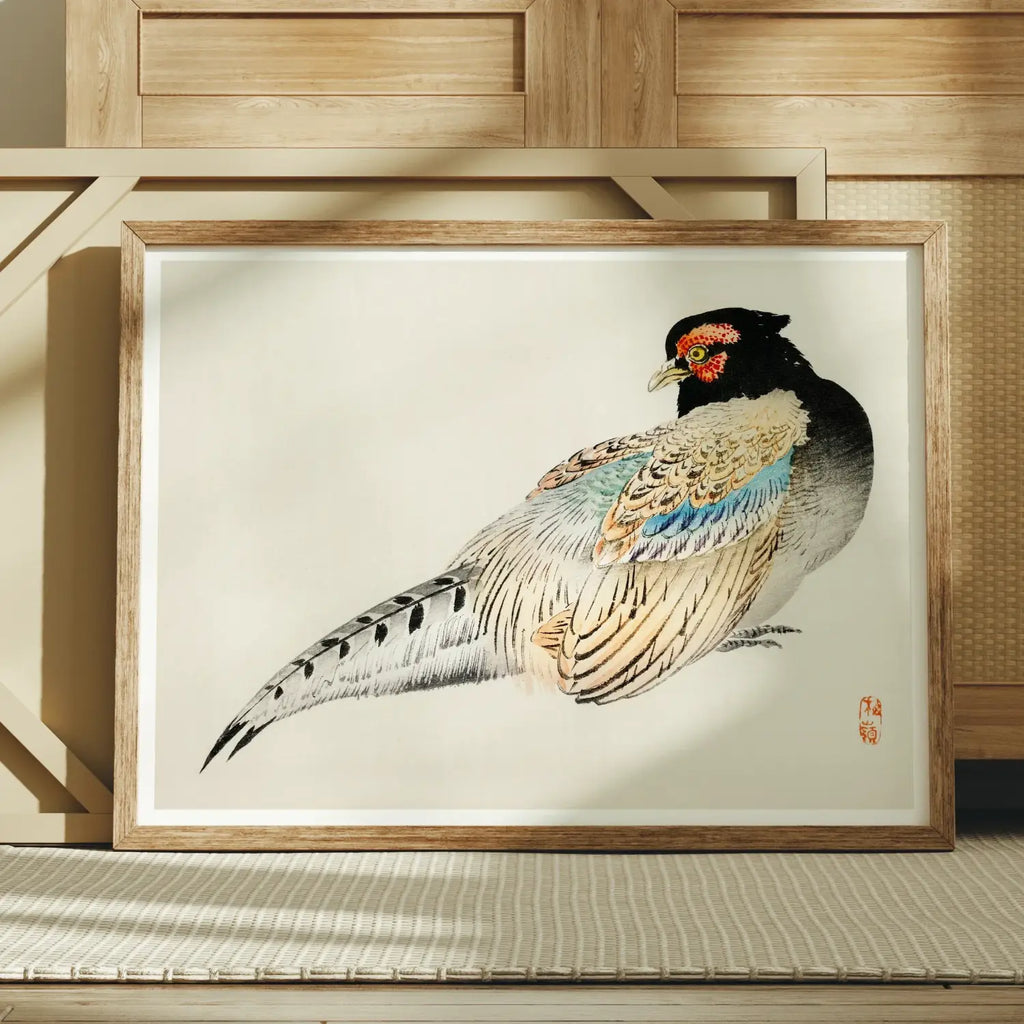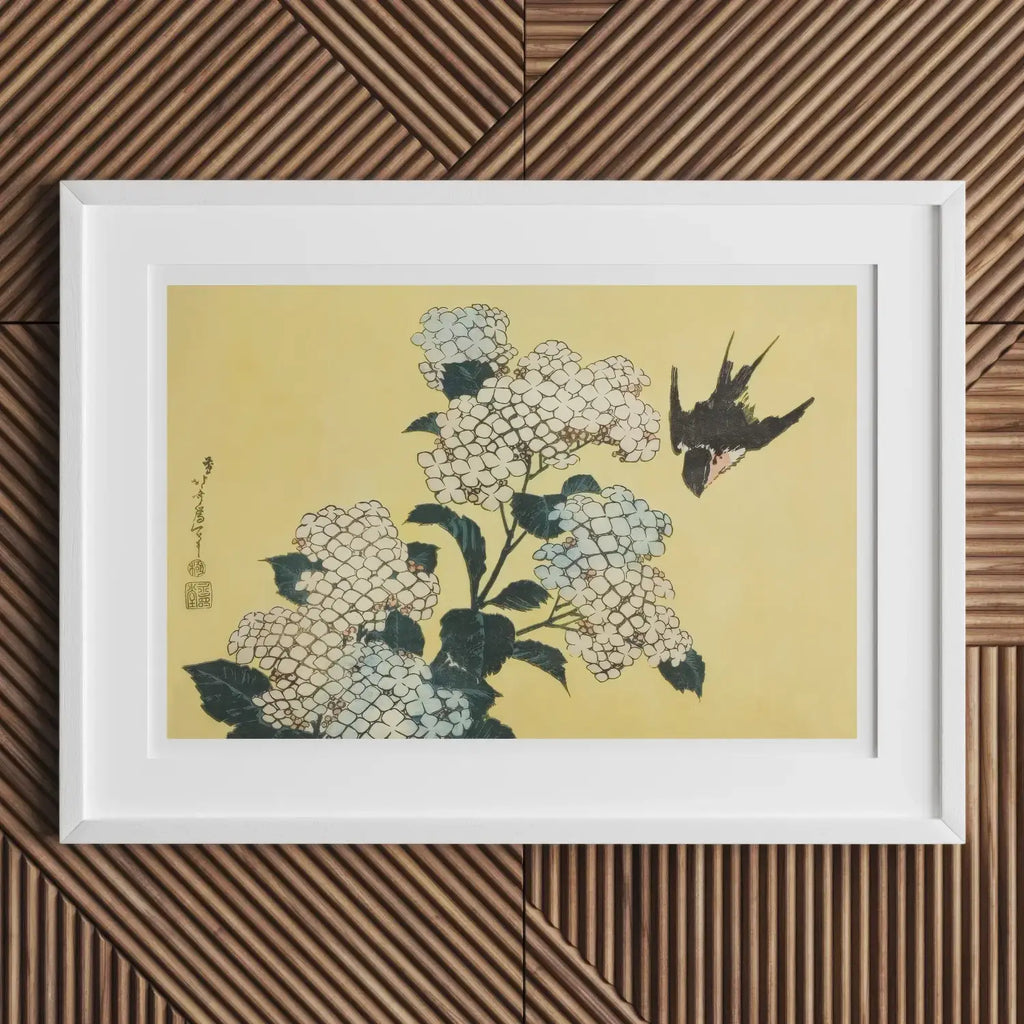
Avian Oaths: 10 Woodblock Prints of Bird Memory
Birds beckon from the paper. Each a totem of flight and stillness, myth and botanical devotion. Their wings beat against the skin of centuries, captured in the fine rain of pigment that echoes a thousand seasons of Japanese ritual and whispered ceremony.
Lean closer to find hydrangea’s blue breath mingling with the red of phoenix plumage. Every print an artifact of the mind. Psychic relics of woodblock and brushstroke. Visual psalms in which feather’s edge and petal’s curve tells stories of transformation.
This is no gallery wall. It’s an incantation of avian iconography.
1
Hydrangea & Swallow – Hokusai Ukiyo-e Woodblock Print
See the swallow’s dive arrested mid-flight. A hydrangea’s ephemeral cloud coiled beneath. Blues and whites rippling like moonlit water over a temple pond. Each petal a whispered offering.
Hokusai’s print binds motion and stillness into a fleeting bloom of exaltation: the bird’s wings stretched, the cluster’s scented hush. The swallow’s beak cutting the air like a fine brushstroke tethering sky to garden.
You might read the print as a relic of Edo imagination, a tale of transient beauty etched into Japanese washi. And the golden hue behind the bird casts the scene with that reverence. A shimmering memory that flickers each time your eye returns.
2
Japanese Pheasant – Kōno Bairei Kacho-e Bird Art Print

Trace the burnished glow of this pheasant’s breast. Flame and shadow fused in Meiji artistry. The pheasant’s stare cleaves the page, a gaze that once might have stalked the undergrowth of a Kyoto grove. And Kōno Bairei’s Maruyama-Shijō precision maps the ruffle of each feather, transforming the bird into a living archive of color.
Let yourself linger over the beak’s curve, the minute scales of foot, each a word in Bairei’s lexicon of avian nobility. For this is no study of birdsong; it is a page torn from the saga of natural law, where color and line narrate a solitary grandeur.
3
Woodblock Crane – Taguchi Tomoki Art Print

The crane lifts its teal wings, a motion held mid-call. Crimson feathers flare at the edges, the ochre body pulsing with vitality as Edo gives way to Meiji's flight.
Tomoki’s woodblock technique captures the crane’s proud stance: a balance of movement and stillness, of line and color. Each stroke is a testament to the precision of the craftsman’s hand, an echo of temple gates opening at dawn while birdsong echoes through the halls.
The crane’s head is forever held high. A spirit of longevity and grace summoned from the memory of pine and water.
4
White Phoenix – Kamisaka Sekka Momoyogusa Art Print

Sekka’s white phoenix emerges from a field of golden myth. Each feather an invocation of celestial heat. Eyes burning with the light of legend, its form elongated into a line of ascension.
The jade accented tail becomes an arabesque of hope, curling in patterns that recall incense smoke in a Kyoto temple. The print is a meditation on the cycles of burning and rebirth, of silence that crackles beneath the skin of the sky.
And in this print, the phoenix does not rise, it lingers. A memory of flight poised at the edge of the possible.
5
Cranes from Momoyogusa – Kamisaka Sekka Art Print
Three cranes emerge from the pine thicket: stark black beaks, long white necks, crimson crowns. Sekka’s Momoyogusa binds the ephemeral to the eternal, a trinity of cranes rising from the green hush of Rinpa reverie.
The pine needles lie like calligraphy, each a stroke of ancestral script. The cranes’ forms stand against the whisper of the forest—three prayers to longevity and the soul’s quiet pilgrimage.
This art print is a fragment of ritual. A place where nature becomes incantation, and the memory of flight becomes a stillness deeper than rest.

6
Twin Flame Phoenix – Taguchi Tomoki Art Print

Taguchi Tomoki’s russet-hued phoenixes share a secret geometry, mirrored forms that seem to sway in silent accord. Twisting in slow choreography. And in each beak you see the mouth of myth. An ancient tale whispered in the cedar halls of Edo.
Tomoki’s Edo period vision captures the avian spirits as yokai of flight, their symmetry a mirror of cosmic cycles. Linger on the feathers to find that each line is a breath, each curl a hidden word.
And in their poised stillness, you sense the eternally coiled surge of fire and rebirth.
7
Peregrine Falcon – Kōno Bairei Meiji Era Bird Art Print

Stand before this falcon and be struck by its gaze of orange flame. The brush conjures a bird of sudden speeds, pinned to paper but ready to fracture the air.
Bairei’s 1913 Barei Gakan print channels the Meiji spirit: a confluence of the old world and the new, a fusion of realism and reverence. The creamy parchment ground softens the falcon’s silhouette, but the claws are tense with poised intention.
In the falcon’s calm, you sense the potential for flight that will never fade, a moment that might burst open at any second.
8
Japanese Hawk – Tosa Mitsuoki Edo Period Bird Art Print
This hawk perches in sovereign calm, Tosa Mitsuoki’s brushwork shimmering like a moonlit prayer. Its feathers lie in careful geography, each barb a record of the painter’s devotion to the hawk’s quiet dignity of place and purpose. While a pink cord trails down like a kabuki actor’s flourish, the vibrant mark of a stage set for stories untold.
Blue frames the bird’s stoic presence, but it is the hawk’s gaze that captures: an ancient alertness, the echo of falconers’ commands. Because here, the avian spirit is not a metaphor but a window into the fierce solitude of flight and watchfulness.
9
Sparrow on a Branch – Kōno Bairei Meiji Era Art Print
The wisteria’s lavender breath frames a single sparrow, caught in the hush of dawn. Ochre and umber meld in the sparrow’s plumage, each speck a record of the painter’s watchfulness.
Feel the rustle of wisteria petals, their color a soft echo of spring’s first breath. The branch, gnarled and patient, bears the sparrow’s weight as if it were a promise to the earth.
In this scene, you glimpse the tenderness of Bairei’s naturalism. The deliberate calm of Meiji-era poetry captured in every brushstroke’s heartbeat.
10
Snowy Egret – Kōno Bairei Kacho-e Art Print
The egret balances like a spectral calligraphy brush, each line a feather, each stroke a movement withheld. Its plumage glows with the pale light of dawn, its eye a yellow note of stillness.
Bairei’s Meiji era vision rests the bird against the hush of negative space, an expanse that becomes both air and water. In the egret’s slender form, you find an image of patience. Waiting for fish and the perfect moment when motion becomes grace, power, predator.
This is a study of the sacred geometry of wings and water, and the quiet that connects them.

Step back from these bird art prints and the air seems to hold their echoes. More than images, they're whispers of a vanished world. A testament to flight’s magic and the stillness of devotion.
Here, in this small collection, you find the secret of the floating world: the eternal dance of beauty and the quiet framing ever expanding skies. Where each brushstroke carries centuries of life. Every feather a record of wonder.




















